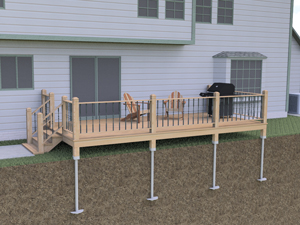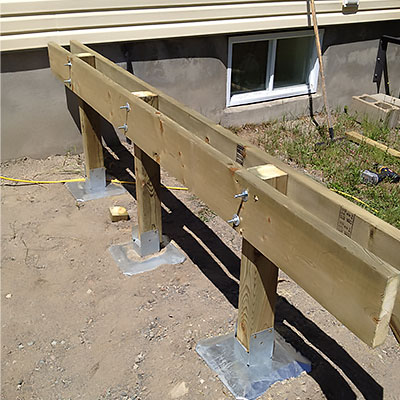Deck Footings Introduced: Recognizing the Trick Elements of a Dependable Deck Structure
Deck Footings Introduced: Recognizing the Trick Elements of a Dependable Deck Structure
Blog Article
Make Sure Security and Longevity With Effectively Installed Deck Grounds
Deck footings might not be the most extravagant aspect of deck building, however they play a vital role in guaranteeing security and longevity. In this conversation, we will check out the value of appropriate deck footings, aspects to take into consideration during setup, different types of grounds readily available, detailed installment overview, and maintenance suggestions for guaranteeing long-lasting grounds.

Importance of Correct Deck Footings
Why are correctly mounted deck footings vital for the stability and longevity of your deck? The response exists in the fundamental function that deck grounds play in sustaining the weight of the entire framework. Deck grounds are the foundation on which the deck rests, transferring the tons from the deck to the ground. When grounds are not effectively mounted, it can cause a variety of issues that jeopardize the stability and durability of the deck.
Firstly, effectively mounted deck grounds disperse the weight of the deck uniformly, stopping any type of irregular settling or sinking. This is particularly essential in areas with unstable soil, as it aids to minimize the threat of the deck collapsing or changing. In addition, well-installed grounds make sure that the deck stays level, avoiding any architectural damage that can happen when a deck becomes unequal.
Secondly, effectively mounted footings provide a strong anchor for the deck, avoiding too much activity and sway. This assists to maintain the architectural stability of the deck, reducing the risk of accidents or injuries. It also decreases the wear and tear on the deck, enabling it to withstand the components and normal usage for a longer time period.
Aspects to Think About for Deck Footing Setup
When setting up deck footings, there are several important factors to consider for correct installment. Various soil kinds have different load-bearing capabilities, so it is vital to carry out a soil test to make certain the grounds can support the weight of the deck and its occupants. By taking into account these elements, you can make sure the correct installment of deck footings and enjoy a lasting and stable deck.
Sorts Of Deck Footings to Select From
There are numerous different types of deck footings readily available for you to pick from. Each type has its very own advantages and disadvantages, so it's important to consider your certain requirements and the conditions of your deck prior to making a decision.
One typical sort of deck ground is the concrete footing. This includes excavating openings in the ground and putting concrete into them to create a strong structure. Concrete footings are resilient and offer excellent security, making them ideal for decks in locations with difficult soil problems or high wind tons.
One more option is the helical pier footing, which includes a steel shaft with helical plates that are screwed into the ground. These grounds are fast to install and can be used in numerous soil types, consisting of sandy or clay soils. They are also adjustable, permitting simple leveling of the deck.
Sonotube grounds are one more prominent choice. These grounds are developed by putting a cardboard tube in a hole and loading it with concrete. Sonotube grounds are relatively simple to mount and offer adequate security for smaller decks or in areas with less demanding soil conditions.

When selecting the kind of deck ground, it's crucial to consider factors such as soil conditions, deck dimension and weight, neighborhood building ordinance, and individual choices. By picking the ideal ground type, you can make sure the security image source and durability of your deck.
Step-by-Step Guide for Installing Deck Footings

Figure out the location: Begin by noting the exact setting of each ground making use of stakes and string (Deck Footings). Take right into account any regional building regulations or regulations concerning trouble distances
Dig the holes: Utilize a blog post hole digger or an auger to dig the openings for the grounds. The depth will depend upon the frost line in your location and the sort of soil. Typically, a deepness of at the very least 36 inches is recommended for stability.
Degree the openings: Make certain that all-time lows of the holes are level (Deck Footings). This can be achieved by using a level or a straight board throughout the top of the openings
Add gravel: Place a layer of Click Here gravel at the end of each hole to enhance drain and stop the footing from penetrating the soil gradually.
Place the ground kinds: Put the ground creates right into the openings, ensuring they are centered and level. Use stakes to secure them in place.
Mix and put concrete: Comply with the directions on the concrete mix bag to prepare the concrete. Put the concrete right into the ground types, filling them totally.
Smooth the surface: Use a trowel to smooth the surface of the concrete and remove any air pockets. Allow the concrete to cure according to the manufacturer's instructions.
Maintenance Tips for Durable Deck Grounds
Correct upkeep is vital for making sure the durability and stability of deck footings. By regularly inspecting and keeping your deck grounds, you can avoid damage and potential safety and security dangers. One crucial aspect of upkeep is to on a regular basis look for any indicators of damage, such as fractures or movement in the grounds. It is important to resolve them promptly to stay clear of additional damages. if you discover any kind of problems.
Regular cleansing is additionally vital for maintaining deck footings. Particles, plant life, and dirt can build up around the grounds, which can lead to moisture buildup and degeneration. Cleansing the grounds frequently, making use of a stress or a brush washer, can help prevent these issues and expand the life expectancy of your deck.
Along with cleansing, it is crucial to maintain the area around the grounds clear of any blockages. Stay clear of piling items against the footings or allowing plants to grow as well near to them. These obstructions can catch wetness and trigger the grounds to degrade in time.
Finally, normal resealing of the grounds is suggested to protect them from dampness and various other ecological variables. Using a waterproof sealant can help avoid water damage and extend the lifespan of the footings.
Conclusion
To conclude, proper installment of deck grounds is try here crucial for guaranteeing stability and longevity of your deck. Variables such as dirt kind, tons capability, and regional building regulations need to be taken into consideration when choosing the appropriate kind of deck footings. Following a step-by-step overview for installment and routine maintenance will certainly aid to make certain the grounds stay durable and long lasting.
In this discussion, we will discover the value of appropriate deck footings, variables to take into consideration during setup, different kinds of grounds available, detailed setup guide, and upkeep suggestions for making certain resilient footings. Deck grounds are the foundation on which the deck relaxes, moving the tons from the deck to the ground.One common kind of deck footing is the concrete ground. Insert the ground forms: Put the footing creates into the openings, ensuring they are focused and level.In final thought, proper installation of deck footings is essential for making certain stability and long life of your deck.
Report this page